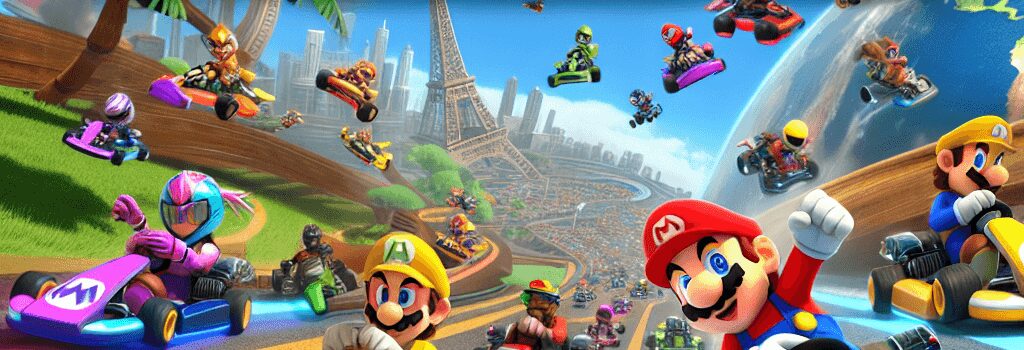Mario Kart World Sets a New Benchmark: $80 Price Reflects Historical Trends & Future Implications

Nintendo’s recent announcement that Mario Kart World would carry a suggested retail price of $80 in the US has sparked significant discussion across the industry. While the figure may appear elevated compared to the pricing on current platforms like the Switch, a deeper dive into historical data reveals that adjusting for inflation, this price point mirrors trends experienced by gamers over the past 40+ years.
Historical Context of Video Game Pricing
For decades, console gaming prices have gradually increased both in nominal terms and when adjusted for inflation. In the early years, a game cartridge priced between $30 and $40 in the 1980s would equate to well over $100 in today’s dollars. For example, Centipede on the Atari 2600 retailed for $34.99 in 1983; using the Bureau of Labor Statistics CPI calculator, this price converts to roughly $90 in February 2025 dollars. This historical perspective underscores that what may seem like a steep price increase today has solid roots in longstanding economic trends.
The Shift in Price Trends
As the gaming industry moved from cartridges to CD and later disc-based systems, pricing strategies evolved. By 2008, a standard top-tier disc-based release was priced at around $59.99. However, even with these lower nominal prices, inflation-adjusted values from the early 2000s suggest that consumers were effectively paying closer to $90 in today’s money. The stability of the $60 price point during the 2010s masked the underlying impact of rising inflation, which has now pushed the real value of baseline game pricing closer to $80.
Expert Analysis on Inflation and Pricing Strategy
Industry experts, including Nintendo Vice President of Player & Product Experience Bill Trinen, have emphasized that the ongoing inflationary pressure is reshaping pricing norms across the board. Annual inflation rates, which have recently soared beyond the historical 2% to 3% range, are eroding the purchasing power of consumers. For instance, an $80 game in 2025 dollars is equivalent to spending about $65 back in 2020, highlighting why a shift from a nominal $60 to $80 isn’t as sudden as it appears when viewed through an economic lens.
Technical Breakdown: Adjusting Historical Prices
A rigorous methodology, drawing on sources such as scanned retail catalogs, archived digital storefronts, and contemporaneous press reports, has been used to analyze historical game pricing. Researchers created a representative ‘basket’ of games across eight distinct genres for various reference years. Key technical steps included:
- Data Collection: Cataloged data from as early as 1982, combined with later digital documentation, allowed for a comprehensive view of game launch prices.
- Inflation Normalization: Prices were adjusted using the Bureau of Labor Statistics CPI calculator, ensuring that historical prices could be directly compared to 2025 dollars.
- Weighting by Genre: Averages were derived from the highest asking prices in categories such as sports, action, and adventure, smoothing out anomalies like collector’s editions.
Consumer Impact and the Bundled Experience
While the adjusted figures validate the $80 price tag as a natural progression in gaming economics, consumer affordability remains a critical consideration. Recognizing this, Nintendo is offering a $499 bundle that includes the Switch 2 and Mario Kart World. This bundle effectively values the game at approximately $50 when purchased with the hardware, providing gamers a compromise that may ease the initial sticker shock of the stand-alone $80 price.
Future Trends and Industry Innovations
Looking to the future, this pricing strategy could establish a new benchmark for premium game releases. Just as NBA 2K21 pioneered a $70 price point five years ago, Mario Kart World may well be remembered for cementing the $80 tier as the new norm. Analysts anticipate that major publishers will follow Nintendo’s lead as inflation and the increasing costs associated with game development continue to push upward pricing boundaries. Moreover, technological advancements in game development and enhanced hardware capabilities are likely to drive further investments, which in turn could justify higher base prices for blockbuster titles.
Conclusion
Mario Kart World’s $80 price tag should be seen not as a departure from tradition but as a natural outcome of decades-long pricing trends in gaming. From the era of pricey cartridges to the relative affordability of disc-based releases, historical pricing adjusted for inflation shows that this new high-water mark aligns well with past standards. As inflation continues to influence the market, future game titles may increasingly adopt a similar pricing model, ensuring that the economics of game development and consumer expectations evolve in tandem.
Source: Ars Technica